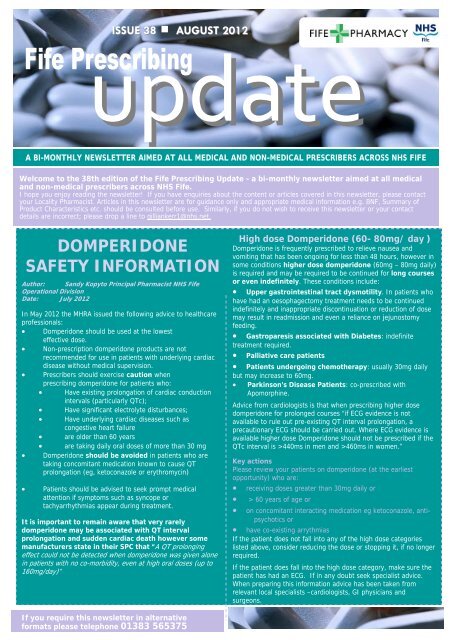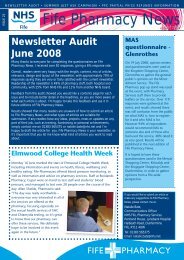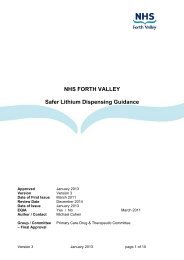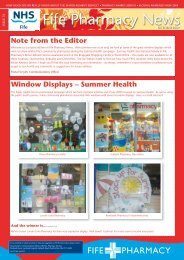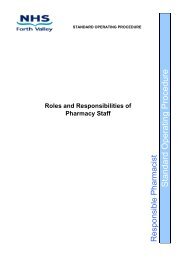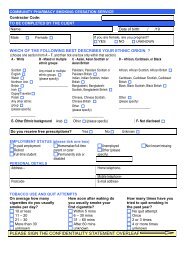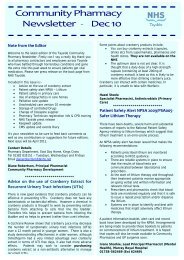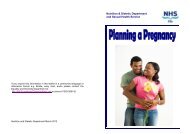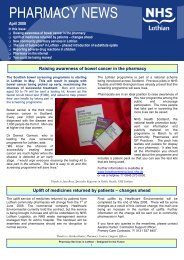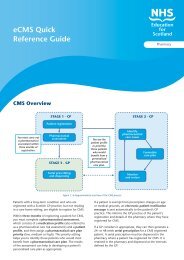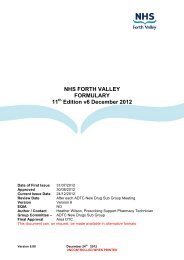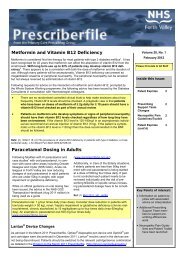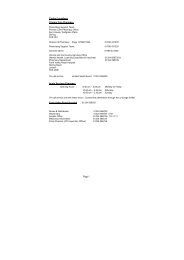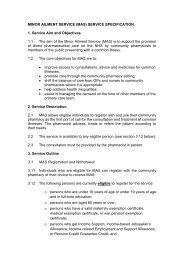Fife Prescribing Update 38 - Community Pharmacy
Fife Prescribing Update 38 - Community Pharmacy
Fife Prescribing Update 38 - Community Pharmacy
You also want an ePaper? Increase the reach of your titles
YUMPU automatically turns print PDFs into web optimized ePapers that Google loves.
ISSUE <strong>38</strong> AUGUST 2012<br />
A BI-MONTHLY NEWSLETTER AIMED AT ALL MEDICAL AND NON-MEDICAL PRESCRIBERS ACROSS NHS FIFE<br />
Welcome to the <strong>38</strong>th edition of the <strong>Fife</strong> <strong>Prescribing</strong> <strong>Update</strong> - a bi-monthly newsletter aimed at all medical<br />
and non-medical prescribers across NHS <strong>Fife</strong>.<br />
I hope you enjoy reading the newsletter! If you have enquiries about the content or articles covered in this newsletter, please contact<br />
your Locality Pharmacist. Articles in this newsletter are for guidance only and appropriate medical information e.g. BNF, Summary of<br />
Product Characteristics etc. should be consulted before use. Similarly, if you do not wish to receive this newsletter or your contact<br />
details are incorrect; please drop a line to gilliankerr1@nhs.net.<br />
DOMPERIDONE<br />
SAFETY INFORMATION<br />
Author: Sandy Kopyto Principal Pharmacist NHS <strong>Fife</strong><br />
Operational Division<br />
Date: July 2012<br />
In May 2012 the MHRA issued the following advice to healthcare<br />
professionals:<br />
• Domperidone should be used at the lowest<br />
effective dose.<br />
• Non-prescription domperidone products are not<br />
recommended for use in patients with underlying cardiac<br />
disease without medical supervision.<br />
• Prescribers should exercise caution when<br />
prescribing domperidone for patients who:<br />
• Have existing prolongation of cardiac conduction<br />
intervals (particularly QTc);<br />
• Have significant electrolyte disturbances;<br />
• Have underlying cardiac diseases such as<br />
congestive heart failure<br />
• are older than 60 years<br />
• are taking daily oral doses of more than 30 mg<br />
• Domperidone should be avoided in patients who are<br />
taking concomitant medication known to cause QT<br />
prolongation (eg, ketoconazole or erythromycin)<br />
• Patients should be advised to seek prompt medical<br />
attention if symptoms such as syncope or<br />
tachyarrhythmias appear during treatment.<br />
It is important to remain aware that very rarely<br />
domperidone may be associated with QT interval<br />
prolongation and sudden cardiac death however some<br />
manufacturers state in their SPC that “A QT prolonging<br />
effect could not be detected when domperidone was given alone<br />
in patients with no co-morbidity, even at high oral doses (up to<br />
160mg/day)”<br />
High dose Domperidone (60- 80mg/ day )<br />
Domperidone is frequently prescribed to relieve nausea and<br />
vomiting that has been ongoing for less than 48 hours, however in<br />
some conditions higher dose domperidone (60mg – 80mg daily)<br />
is required and may be required to be continued for long courses<br />
or even indefinitely. These conditions include:<br />
• Upper gastrointestinal tract dysmotility. In patients who<br />
have had an oesophagectomy treatment needs to be continued<br />
indefinitely and inappropriate discontinuation or reduction of dose<br />
may result in readmission and even a reliance on jejunostomy<br />
feeding.<br />
• Gastroparesis associated with Diabetes: indefinite<br />
treatment required.<br />
• Palliative care patients<br />
• Patients undergoing chemotherapy: usually 30mg daily<br />
but may increase to 60mg.<br />
• Parkinson’s Disease Patients: co-prescribed with<br />
Apomorphine.<br />
Advice from cardiologists is that when prescribing higher dose<br />
domperidone for prolonged courses “if ECG evidence is not<br />
available to rule out pre-existing QT interval prolongation, a<br />
precautionary ECG should be carried out. Where ECG evidence is<br />
available higher dose Domperidone should not be prescribed if the<br />
QTc interval is >440ms in men and >460ms in women.”<br />
Key actions<br />
Please review your patients on domperidone (at the earliest<br />
opportunity) who are:<br />
• receiving doses greater than 30mg daily or<br />
• > 60 years of age or<br />
• on concomitant interacting medication eg ketoconazole, antipsychotics<br />
or<br />
• have co-existing arrythmias<br />
If the patient does not fall into any of the high dose categories<br />
listed above, consider reducing the dose or stopping it, if no longer<br />
required.<br />
If the patient does fall into the high dose category, make sure the<br />
patient has had an ECG. If in any doubt seek specialist advice.<br />
When preparing this information advice has been taken from<br />
relevant local specialists –cardiologists, GI physicians and<br />
surgeons.<br />
If you require this newsletter in alternative<br />
formats please telephone 01<strong>38</strong>3 565375
Specialist Infant Formulas for Cow’s Milk Protein Allergy<br />
There has been a significant rise in the prevalence of all<br />
allergic disease over the last decade 1 . Food allergy affects as<br />
many as 6% of young children and 3-4% of adults 2 . Cow’s<br />
milk is the most common food allergen in infants. It has<br />
major nutritional implications as cow’s milk, in the form of<br />
standard infant formula, is often given as a sole or main<br />
source of nutrition. Many infants with cow’s milk protein<br />
allergy (CMPA) develop symptoms within 1 week of the<br />
introduction of standard infant formula. Between 5% and 15%<br />
of infants show symptoms suggestive of CMPA. However,<br />
estimates of the prevalence of CMPA in Europe vary from 2%<br />
to 7.5% in the first year 3 . In the UK, approximately 2% of<br />
infants develop CMPA 4.<br />
The rapid, alarming increase in expenditure of hypoallergenic<br />
formula in the community in <strong>Fife</strong> far exceeds this estimate for<br />
the UK. These concerns are mirrored throughout other health<br />
boards in Scotland and the rest of the UK. The total spend of<br />
hypoallergenic formula used in the management of CMPA in<br />
<strong>Fife</strong> increased from £146,687 in the financial year 2007-<br />
2008 to £220,870 in the last financial year (2011-2012). Due<br />
to the increased awareness of CMPA amongst the general<br />
public and the parent’s ability to purchase initial supplies of<br />
hypoallergenic formula over the internet, there is a huge<br />
amount of pressure on healthcare professionals working in<br />
primary to provide or carry on a prescription for<br />
hypoallergenic formula.<br />
Key Points:<br />
• refer to the <strong>Fife</strong> Paediatric Dietitians<br />
guidelines available as Appendix 9B of<br />
Chapter 9<br />
• Nutramigen 1 and 2 are the preferred<br />
formulas in NHS <strong>Fife</strong><br />
1. Select Committee on Science and Technology. Science and<br />
Technology – Sixth Report. London: House of Lords<br />
Technology Committee. 2007<br />
2. Department of Health Allergy Services Review Team. A review<br />
of services for allergy. The epidemiology, demand for and<br />
provision of treatment and effectiveness of clinical<br />
interventions. Department of Health. July. 2006.<br />
3. Agostoni C, Braegger C, Decsi T et al. Breast-feeding: a<br />
commentary by the ESPGHAN committee on Nutrition. J<br />
Pediatr Gastroenterol Nutr 2009; 49: 112-25.<br />
4. Sicherer SH. Food allergy. Lancet 2002; 360 (9334) 701-710.<br />
There are a variety of hypoallergenic formulas available on<br />
prescriptions, which vary in hypoallergenicity and cost.<br />
Nutramigen 1 and 2 are the preferred choice of<br />
hypoallergenic formulas for the management of CMPA<br />
in <strong>Fife</strong> and are listed in the NHS <strong>Fife</strong> Formulary<br />
( Appendix 9B).<br />
The <strong>Fife</strong> Paediatric Dietitians have produced a guide for<br />
healthcare professionals working in primary care on the<br />
‘Diagnosis and Management of Infants with Suspected<br />
Cow’s Milk Protein Allergy, which has also been ratified by<br />
the Area Drug and Therapeutics Committee. The aim of the<br />
document is to:-<br />
• provide an awareness and understanding of the<br />
diagnosis and management of cow’s milk protein<br />
allergy<br />
• facilitate decision on appropriate formula choice<br />
• indicate when a referral to secondary care<br />
(Dietitian or Paediatrician) is appropriate<br />
Within the document is a care pathway (see right), which<br />
has been adapted from NICE, 2011 Food allergy in children<br />
and young people, based on our specific <strong>Fife</strong> allergy<br />
population and current allergy provision. The document can<br />
be accessed via the <strong>Fife</strong> formulary: www.fifeadtc.scot.nhs.uk<br />
Refer to Chapter 9 – Appendix 9B.<br />
FIFE PRESCRIBING UPDATE ISSUE <strong>38</strong> AUGUST 2012
Wasted Medicines in <strong>Fife</strong> –<br />
Only order what you need<br />
NHS <strong>Fife</strong> is launching a campaign on 10<br />
September 2012 to reduce the amount of<br />
wasted medicines. The campaign aims to<br />
highlight the costs involved as a result of<br />
over-ordering of medicines, particularly on<br />
repeat prescriptions, or continuing to order<br />
medicines no longer needed.<br />
Wasted medicines cost NHS <strong>Fife</strong> over<br />
£2 million per year.<br />
This is the equivalent of around 110<br />
community nurses, 80 community midwives<br />
or 54 community dentists.<br />
The quantity of medicines returned to <strong>Fife</strong><br />
pharmacies is also equivalent to filling an 8<br />
tonne skip every 8 weeks.<br />
The campaign targets not just the general<br />
public, but Care Home staff, GPs, pharmacy<br />
staff, and NHS <strong>Fife</strong> staff.<br />
The campaign includes advertising on buses, at train<br />
stations, stands at 3 <strong>Fife</strong> shopping centres, leaflets<br />
and posters displayed at libraries, leisure centres, all<br />
NHS <strong>Fife</strong> hospitals, GP practices and care homes.<br />
<strong>Fife</strong> pharmacies are also<br />
distributing leaflets and<br />
flyers with displays<br />
during the campaign.<br />
Look out for posters,<br />
leaflets and flyers<br />
relating to the<br />
campaign, as this is an<br />
issue which affects us<br />
all, and can only be of<br />
benefit when we reduce<br />
the amount of wasted<br />
medicines in <strong>Fife</strong>.<br />
Are Sunscreens Prescribable on the NHS?<br />
GPs are reminded that the Advisory Committee on Borderline Substances (ACBS) recommends products on the basis<br />
that they may be regarded as drugs for the management of specified conditions. Sunscreens are prescribable for<br />
photosensistive skin disorders including genetic disorders, vitiligo, following radio–therapy, photo–aggravated rosacea,<br />
or chronic or recurrent herpes simplex labialis.<br />
The sunscreen preparations that can be prescribed can be found in the BNF Subsection 13.8.1. The NHS <strong>Fife</strong> formulary<br />
choices are:<br />
Sunsense ® Ultra lotion SPF 50<br />
Uvistat ® sun cream SPF 50 - this is fragrance-free<br />
<strong>Prescribing</strong> Notes:<br />
• Sunscreens should ONLY be prescribed in line with ACBS recommendations<br />
• For optimum photoprotection sunscreen preparations should be applied thickly and frequently (approximately 2<br />
hourly)<br />
• Sunscreens may rarely cause allergic reactions. The choice of sunscreen depends on individual patient need,<br />
tolerance and evidence of sensitivity to excipients.<br />
FIFE PRESCRIBING UPDATE ISSUE <strong>38</strong> AUGUST 2012
Every Efficiency Matters<br />
Dutasteride to Finasteride<br />
Clinical evidence<br />
Both dutasteride and finastaride are used for the<br />
treatment of benign prostatic hypertrophy (BPH),<br />
with finasteride being the agent of choice in<br />
Scottish Health boards including NHS <strong>Fife</strong>.<br />
Finasteride and dutasteride are equally effective<br />
for relieving the lower urinary tract symptoms<br />
associated with benign prostatic hyperplasia in<br />
men with larger prostates. They have similar<br />
adverse effect profiles, and both have a slow onset<br />
of action. 1 Generic versions of finasteride are<br />
available whilst dutasteride is more expensive and<br />
patent protected until 2017.<br />
What is the problem?<br />
Both dutasteride and finastaride are used for the<br />
treatment of benign prostatic hypertrophy (BPH),<br />
with finasteride being the 1st line choice in<br />
Scottish Health boards including NHS <strong>Fife</strong>. Generic<br />
versions of finasteride are available whilst<br />
dutasteride is presently patent protected and is<br />
more expensive.<br />
Whilst finasteride is the first line NHS <strong>Fife</strong><br />
formulary choice, it only accounts for 60% of all 5<br />
alpha reductase inhibitor tablets prescribed and<br />
15% of the overall costs. Chart 1 shows that NHS<br />
<strong>Fife</strong> is the highest spending health board per head<br />
of population for dutasteride, with a spend per<br />
head of population more than 2.5 times the<br />
Scottish average.<br />
NHS LANARKSHIRE<br />
NHS DUMFRIES & GALLOWAY<br />
NHS GRAMPIAN<br />
NH S SCOT LA ND<br />
NHS BORDERS<br />
NHS FIFE<br />
Chart 1<br />
Chart 1<br />
0.00 20.00 40.00 60.00 80.00 100.00 120.00 140.00 160.00 180.00<br />
Cost (GIC)/ 1000 Patients<br />
<strong>Fife</strong> currently spends £230k annually on dutasteride. The<br />
price of dutasteride (Avodart®) has recently increased by<br />
50% from £19.80 to £29.77 for 30 tablets resulting in an<br />
annual increase in cost of dutasteride (Avodart®) of<br />
£100k.<br />
Chart 2<br />
Finasteride 5mg<br />
Finasteride 5mg +<br />
Tamsulsoin 400mcg<br />
Combodart®<br />
Dutasteride 500mcg<br />
(Avodart®)<br />
Dutasteride 500mcg<br />
(Avodart®) + Tamsulosin<br />
400mcg<br />
Annual Cost of drugs for Benign Prostatic Hyperplasia*<br />
£23.79<br />
£86.06<br />
£240.24<br />
£361.21<br />
£423.47<br />
£0.00 £50.00 £100.00 £150.00 £200.00 £250.00 £300.00 £350.00 £400.00 £450.00<br />
*Drug tariff August 2012 and pricing letter from GSK dated 21/6/12<br />
Why does this matter?<br />
As with all public funded budgets, there is a finite amount of<br />
resource available. Savings made in prescribing will have<br />
positive impacts on other parts of the NHS e.g. maintaining<br />
funding available for staff and services.<br />
What are we doing about it?<br />
Over the next few months, practice pharmacists will be<br />
reviewing patients in primary care on dutasteride, according<br />
to a protocol agreed with Urology consultants. Where<br />
appropriate, recommending to GPs that they are changed to<br />
finasteride. Patients on the dutasteride/tamsulosin<br />
combination product (Combodart®) will be changed to<br />
individual finasteride tablets and tamsulosin capsules.<br />
If 60% of patients are switched then NHS <strong>Fife</strong> will make an<br />
annually saving of £186k.<br />
Key messages:<br />
• There is no clinically significant difference between<br />
dutasteride and finasteride.<br />
• Practice pharmacists will be reviewing patients on<br />
dutasteride over next few months.<br />
• Don’t start NEW patients on dutasteride unless<br />
recommended by urologists for patients with very<br />
large prostates and very severe symptoms (patient<br />
pathway for new patients in development).<br />
By switching appropriate patients from dutasteride to<br />
finasteride, it is hoped to make an efficiency saving of £186k<br />
1. NHS Clinical knowledge Summaries. Lower<br />
urinary tract symptoms in men, age-related (including<br />
symptoms of benign prostatic hyperplasia/<br />
hypertrophy) - <strong>Prescribing</strong> information<br />
www.cks.nhs.uk<br />
FIFE PRESCRIBING UPDATE ISSUE <strong>38</strong> AUGUST 2012


